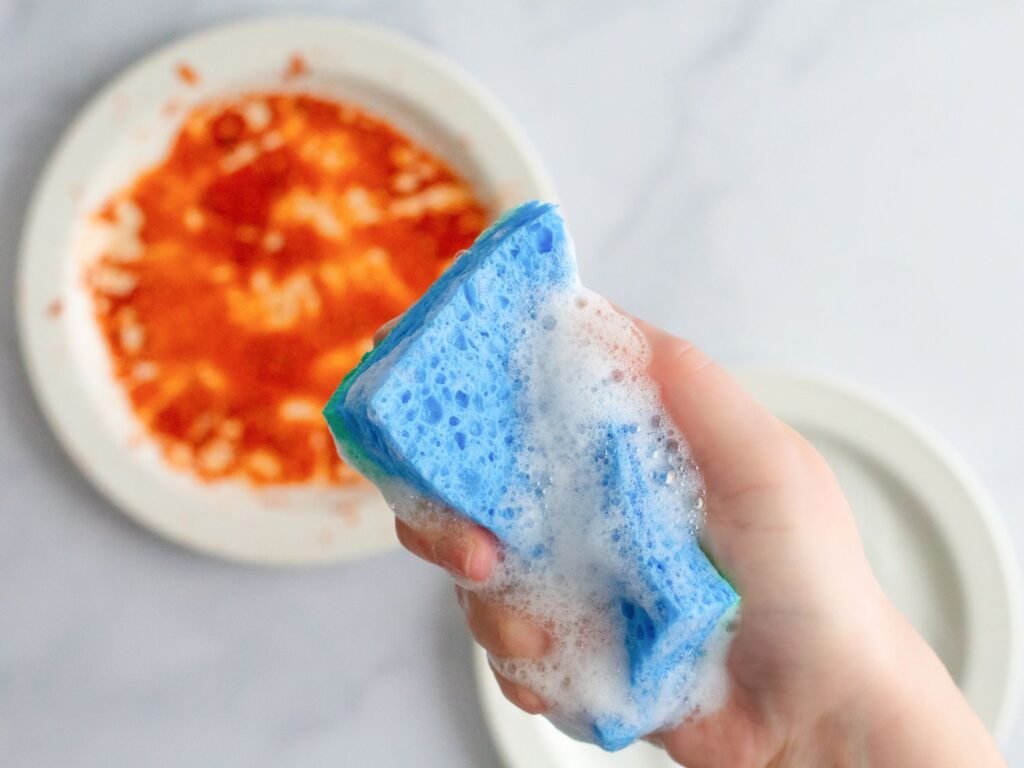Despite being doused in hot, soapy water daily, sponges are the perfect breeding ground for microorganisms. Most of these are relatively harmless environmental bacteria that live all around us, but sponges can also harbor pathogens such as Campylobacter, Salmonella, Staphylococcus, E. coli, and Listeria. If you don’t treat your sponge right, that growth can be accelerated.
Anyone who knows me knows I’m a stickler for safety. (Always wear a bike helmet, friends!) This also applies to food safety—I always test the temperature of meat and other foods to ensure they’re fully cooked, pack my picnic coolers with ice, and use separate cutting boards to prevent cross-contamination. But even with my rule-following tendencies and passion for peace of mind, I had never given much thought to kitchen sponges. I use a handy sink caddy to keep them organized, toss them when they get grungy, and that’s that. Recently, I spoke with a food safety expert to find out how dirty kitchen sponges become—and it turns out that most people aren’t caring for or replacing their sponges as often as experts recommend.
How Dirty Do Sponges Get, Really?
Hypothetically, kitchen sponges should stay pretty clean—you douse them daily in hot, soapy water, and what could be cleaner than that? The main issue with sponges is that the same thing that makes them so effective at washing—their absorbency—also makes them the perfect breeding ground for microorganisms.
“Sponges are the perfect place for bacteria to grow,” Karen Fifield, Food Safety Educator at the Michigan State University Extension, tells me. “We don’t keep them super hot, we don’t keep them super cold, and they’re not always dry. The moisture and temperature make a sponge the ideal spot for bacteria to grow.”
The wet, dark environment and food residues inside a sponge can encourage microbes to grow. Most of these are relatively harmless environmental bacteria that live all around us, but sponges can also harbor pathogens such as Campylobacter, Salmonella, Staphylococcus, E. coli, and Listeria. That means they could, in theory, increase the risk of cross-contamination in your kitchen. If you don’t treat your sponge right, such as by not wringing it out or leaving it at the bottom of a wet sink, that growth can be accelerated.
The Best Way to Clean a Sponge
The good news: You can clean a sponge to eliminate virtually all of the bacteria that might be hiding there. The USDA recommends two methods as the most effective: popping your sponge in the microwave or the dishwasher. According to their testing, these methods removed 99.99999 and 99.9998% percent of bacteria from sponges, respectively.
To use the microwave to sanitize a sponge, first ensure that your sponge doesn’t have any metallic fibers (usually in its scrub pad, if it has one)—if it does, skip this method. Saturate the sponge with water to prevent it from catching fire, then microwave it on high for one to two minutes.
To use the dishwasher, place the sponge on the top rack and make sure you use a “heated dry” and/or “sanitize” setting when running the cycle. “I don’t have a dishwasher,” Fifield tells me. “But if I did, I would wash my sponge in it daily.”
The MSU Extension offers one more option to clean your dirty sponge: In a bowl, combine 1/4 teaspoon of concentrated food-safe chlorine bleach (8.25% hypochlorite) with one quart of warm (not hot!) water. Add your sponge and let it soak for one minute. This is the method Fifield uses: At home, she bleaches her sponges and dishcloths in the sink with one teaspoon of bleach and one gallon of warm water after doing the dishes.
How to Reduce Bacteria in Your Sponge
Another way to prevent bacteria from accumulating in your sponge is to wring it thoroughly after each use and place it somewhere it can air dry on all sides, such as on a wire sponge holder. A wet sponge will deteriorate more rapidly than a dry one, so drying your sponge thoroughly between uses will help it last longer.
If you use a sponge to clean surfaces, Fifield says it’s not a bad idea to have separate sponges for dishes and countertops. However, you can use the same sponge for both tasks if you’re sanitizing it regularly.
In all instances, however, you should avoid using a sponge to wipe up juices from raw meat or poultry, as these are a hotbed for pathogens. Instead, use a paper towel with a cleaner or food-grade sanitizing wipe for this task. These options are also better for cleaning your countertops, as a sponge can unwittingly spread bacteria around on your work surfaces.
When to Replace Your Sponge
Even with careful drying and regular sanitizing, no sponge will last forever. The official advice is to change sponges weekly, a recommendation designed to eliminate almost any risk, which, we have to admit, is also pretty wasteful. Obviously, if your sponge is visibly falling apart (food can get trapped in tears or holes under the scrub pad), has black mold spots on the surface, starts to smell, or feels slimy, it’s well past time to replace it.
We aren’t in a position to contradict the official guidance, but if you think you’re unlikely to follow a weekly sponge-swapping routine, at least keep in mind how easy it is to sanitize sponges as described above and make a point of doing so. You can also consider doing as Serious Eats associate editorial director, Megan, does, and cut your sponges in half before use to get more mileage out of each one.

